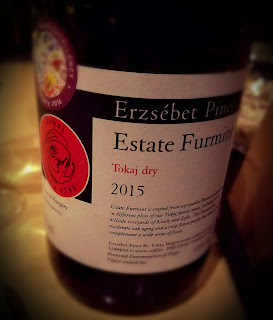Hungary may not spring to mind first when the topic of great wine regions is broached, but that's going to have to change. The area of northeast Hungary has been home to winemaking for at least a thousand years, probably longer. The Furmint grape is used there to produce Tokaji aszú, the dessert wine that has been called the king of wines and the wine of kings. However, there is a movement on to dry things out in Tokaj. Decades of communist rule decimated the region's reputation for wine, but it has been on the upswing since 1990.
Dry wines made from Furmint are now experiencing trendy hotness, and
FurmintUSA came to Beverly Hills to show off a smattering of examples. We gathered at
The Bazaar by José Andres for a dinner of delicious treats paired with the amazing dry Furmint wines of Hungary. Furmint lends itself to a wide range of styles, from light and dry to lively and sparkling to sweet and botrytized.
Balázs Humayer, the co-founder of FurmintUSA, was there to extol the virtues of these great wines which are creating an international buzz. He feels that Hungary is about to become a major player in the U.S. wine market. All that really needs to happen is for American wine drinkers to go exploring as they peruse the wine list or scan the shelves. The dry wines I tasted at the dinner are delicious, food-friendly and deserve to be considered right alongside that Chenin Blanc or Vermentino. In California, seven Hungarian producers are imported by
J.J. Knox of San Diego.
Hungary's shift from sweet to dry wines came about 50 years ago when they realized how good they were. The clay and loess soils of the region sit on a volcanic base which imparts a distinctive minerality to the wines. The wines poured at the dinner fall mostly in the $20 or so range. The dessert wine is more expensive.
The Wines:
Beres Dry Furmint 2016 - This unoaked, beautiful aperitif shows great minerals and acidity and is a fabulous food wine. It paired very well with the olives and the goat cheese and star anise dip.
St. Donat Marga Dry Furmint 2013 - The only wine of the night not from Tokaj, this one hails from Csopak, a village on Lake Balaton. A little oak was used in making this one, as well as concrete amphorae. Smoke, earth and citrus attract on the nose while the palate shows stone fruit and a slight anise note. It's quite complex and was lovely with the King crab in raspberry vinaigrette.
Erzsebet Estate Furmint 2015 - Erzsébet (Elizabeth) Prácser was one of the first female winemakers in Tokaj, setting up shop in the early '90s after Soviet troops ended their three-decade stay in Hungary's streets. There's more salinity in this one and a great acidity. It paired extremely well with with the tomato and liquid mozzarella caprese.
Grof Degenfeld Off-Dry Furmint 2013 - It's a bit like a Riesling, grown in tightly-packed soil.
The pairing was excellent with grilled octopus and chicken béchemel fritters.
Majoros Deák Vineyards Dry Furmint 2015 - I'm told László Majoros is one of the more experimental winemakers in Tokaj. Oak figures into this wine, but it's typically restrained. Notes of smokey and spicy ginger and caramel had me thinking of serving this one for the holidays. It's a great food wine and paired well with the sautéed shrimp.
Barta Oreg Kiraly Dry Furmint 2015 - This wine is made from the grapes of a "grand cru" vineyard. There's a smokey nose, with citrus and anise on the palate.
Demetervin Tribal Tattoo Dry Furmint 2015 - This cuvée from two "grand cru" vineyards does a lot with very little interference from the oak. Smoke, salinity and citrus dominate the nose, while the palate focuses on fruit. It's great with coffee rubbed American Wagyu beef strips.
Demetervin Szamorodni 2013 - Szamorodni is a style, which is sweet like a Sauternes. Aszú is different in that the grapes are harvested singly rather than in whole bunches. This wine shows candy apricots and is a great complement to dessert or can stand as dessert on its own.





















